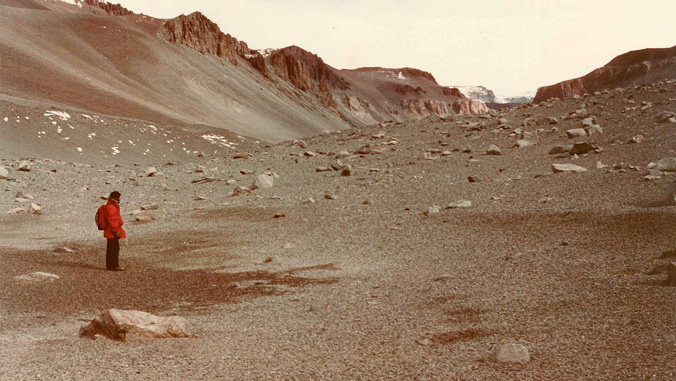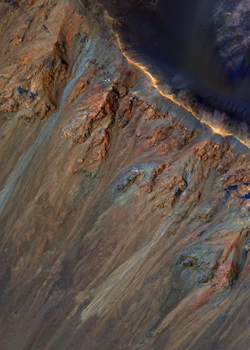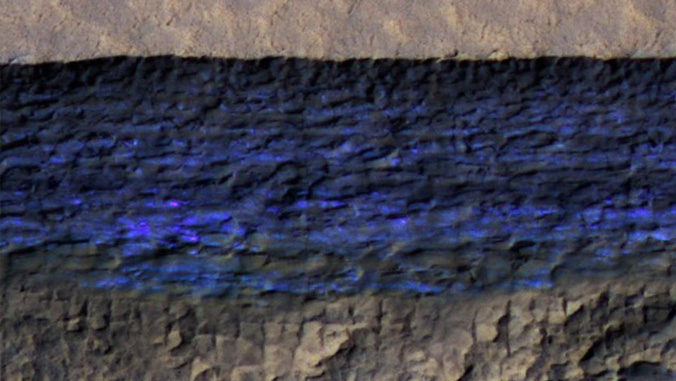Could New Theory Answer What Causes Landslides On Mars?
Using Mars orbiter data, field observations and laboratory experiments, a team of researchers, including Peter Englert, professor in the University of Hawaiʻi at Mānoa School of Ocean and Earth Science and Technology (SOEST), developed a new theory about what is causing landslides on the surface of Mars.
 Wright Valley, Antarctica. (Photo credit: Everett Gibson, NASA Johnson Space Center) Their research was published in Science Advances.
Wright Valley, Antarctica. (Photo credit: Everett Gibson, NASA Johnson Space Center) Their research was published in Science Advances.
Previous ideas suggested that liquid debris flows or dry granular flows caused this movement. However, neither model can completely account for the seasonal martian flow features known as Recurring Slope Lineae (RSL).
The team, led by Janice Bishop, SETI Institute senior research scientist and member of the NASA Astrobiology Institute team, alternatively hypothesizes that small-scale ice melting underground causes changes that make the surface vulnerable to dust storms and wind. As a result, the features appear or expand on the surface of Mars. Further, the team believes that the thin layers of melting ice result from interactions between underground water ice, chlorine salts and sulfates, which create an unstable, liquid-like flowing slush that instigates sinkholes, ground collapse, surface flows and upheave.
Earth sediments parallel Mars samples
 Ice (blue) below the surface at a scarp near Hellas Planitia on Mars. (Photo credit: NASA/JPL/Univ of Arizona)
Ice (blue) below the surface at a scarp near Hellas Planitia on Mars. (Photo credit: NASA/JPL/Univ of Arizona)
Mars analog field investigations on Earth, such as in the Dry Valleys of Antarctica, the Dead Sea in Israel and Salar de Pajonales in the Atacama Desert, show that when salts including gypsum interact with water underground, it causes disruptions on the surface, including collapse and landslides.
The current project arose out of work on sediments from the McMurdo Dry Valleys in Antarctica, one of Earth’s coldest and driest regions. As on Mars, the Dry Valleys’ surface is cold and scoured by dry winds most of the year. However, subsurface permafrost contains water ice, and chemical alteration appears to be occurring below the surface.
To test its theory, the team conducted lab experiments to observe what would occur if they froze and thawed analog samples comprised of chlorine salts and sulfates at low temperatures such as what would be found on Mars. The result was slushy ice formation near -50 °C, gradual melting of the ice from -40 to -20 °C and thin layers of liquid-like water forming along grain surfaces.
Englert, who is based at the Hawaiʻi Institute of Geophysics and Planetology in SOEST, managed efforts to analyze the chemistry of Antarctic sediments from several soil pits and cores, enhancing understanding of the salt enrichment in the near-surface layers.
“Because Dry Valley sediments are analogous to Mars sediments, our experiments can provide clues about the processes that may be occurring on Mars,” said Englert. “Elevated concentrations of chlorine salts and sulfates were found just below the surface in multiple locations we studied in Antarctica’s Wright Valley. The ubiquitous subsurface presence of these salts in Antarctica suggest their presence on Mars and their potential role in triggering landslide processes.”
These findings are examples of UH Mānoa’s goal of Excellence in Research: Advancing the Research and Creative Work Enterprise (PDF), one of four goals identified in the 2015–25 Strategic Plan (PDF), updated in December 2020.
For more information see SOEST’s website.
–By Marcie Grabowski
 Ice (blue) below the surface at a scarp near Hellas Planitia on Mars. (Photo credit: NASA/JPL/Univ of Arizona)
Ice (blue) below the surface at a scarp near Hellas Planitia on Mars. (Photo credit: NASA/JPL/Univ of Arizona)
Publication: J. L. Bishop, et al. Martian subsurface cryosalt expansion and collapse as trigger for landslides. Scientific Reports, (2023). DOI: 10.1126/sciadv.abe4459
Original Story Source: University of Hawaii at Manoa

 Alerts Sign-up
Alerts Sign-up